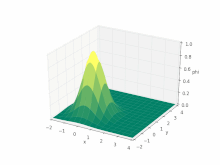Advection
This articleneeds additional citations forverification.(May 2022) |
In the field ofphysics,engineering,andearth sciences,advectionis thetransportof a substance or quantity by bulk motion of a fluid. The properties of that substance are carried with it. Generally the majority of the advected substance is also a fluid. The properties that are carried with the advected substance areconservedproperties such asenergy.An example of advection is the transport ofpollutantsorsiltin ariverby bulk water flow downstream. Another commonly advected quantity is energy orenthalpy.Here the fluid may be any material that contains thermal energy, such aswaterorair.In general, any substance or conserved,extensivequantity can be advected by afluidthat can hold or contain the quantity or substance.
During advection, a fluid transports some conserved quantity or material via bulk motion. The fluid's motion is describedmathematicallyas avector field,and the transported material is described by ascalar fieldshowing its distribution over space. Advection requires currents in the fluid, and so cannot happen in rigid solids. It does not include transport of substances bymolecular diffusion.
Advection is sometimes confused with the more encompassing process ofconvection,which is the combination of advective transport and diffusive transport.
Inmeteorologyandphysical oceanography,advection often refers to the transport of some property of the atmosphere orocean,such asheat,humidity (seemoisture) orsalinity. Advection is important for the formation oforographicclouds and the precipitation of water from clouds, as part of thehydrological cycle.
Mathematical description
[edit]Theadvection equationis a first-orderhyperbolic partial differential equationthat governs the motion of a conservedscalar fieldas it is advected by a knownvelocity vector field.[1]It is derived using the scalar field'sconservation law,together withGauss's theorem,and taking theinfinitesimallimit.
One easily visualized example of advection is the transport of ink dumped into a river. As the river flows, ink will move downstream in a "pulse" via advection, as the water's movement itself transports the ink. If added to a lake without significant bulk water flow, the ink would simply disperse outwards from its source in adiffusivemanner, which is not advection. Note that as it moves downstream, the "pulse" of ink will also spread via diffusion. The sum of these processes is calledconvection.
The advection equation
[edit]The advection equation for a conserved quantity described by ascalar fieldis expressed by acontinuity equation: wherevector fieldis theflow velocityandis thedeloperator. If the flow is assumed to beincompressiblethenissolenoidal,that is, thedivergenceis zero: and the above equation reduces to
In particular, if the flow is steady, then which shows thatis constant along astreamline.
If a vector quantity(such as amagnetic field) is being advected by thesolenoidalvelocity field,the advection equation above becomes:
Here,is avector fieldinstead of thescalar field.
Solution
[edit]
Solutions to the advection equation can be approximated usingnumerical methods,where interest typically centers ondiscontinuous"shock" solutions and necessary conditions for convergence (e.g. theCFL condition).[2]
Numerical simulation can be aided by considering theskew-symmetricform of advection where
Since skew symmetry implies onlyimaginaryeigenvalues,this form reduces the "blow up" and "spectral blocking" often experienced in numerical solutions with sharp discontinuities.[3]
Distinction between advection and convection
[edit]
The termadvectionoften serves as a synonym forconvection,and this correspondence of terms is used in the literature. More technically, convection applies to the movement of a fluid (often due to density gradients created by thermal gradients), whereas advection is the movement of some material by the velocity of the fluid. Thus, although it might seem confusing, it is technically correct to think of momentum being advected by the velocity field in the Navier-Stokes equations, although the resulting motion would be considered to be convection. Because of the specific use of the term convection to indicate transport in association with thermal gradients, it is probably safer to use the term advection if one is uncertain about which terminology best describes their particular system.
Meteorology
[edit]Inmeteorologyandphysical oceanography,advection often refers to the horizontal transport of some property of the atmosphere orocean,such asheat,humidity or salinity, and convection generally refers to vertical transport (vertical advection). Advection is important for the formation oforographic clouds(terrain-forced convection) and the precipitation of water from clouds, as part of thehydrological cycle.
Other quantities
[edit]The advection equation also applies if the quantity being advected is represented by aprobability density functionat each point, although accounting fordiffusionis more difficult.[citation needed]
See also
[edit]Notes
[edit]- ^LeVeque 2002,p. 1.
- ^LeVeque 2002,pp. 4–6, 68–69.
- ^Boyd 2001,p. 213.
References
[edit]- Boyd, John P. (2001).Chebyshev and Fourier Spectral Methods(PDF).Mineola, NY: Courier Corporation.ISBN0-486-41183-4.
- LeVeque, Randall J. (2002).Finite Volume Methods for Hyperbolic Problems.Cambridge University Press.doi:10.1017/cbo9780511791253.ISBN978-0-521-81087-6.













![{\displaystyle \nabla ({\mathbf {u} }{\mathbf {u} })=\nabla \cdot [{\mathbf {u} }u_{x},{\mathbf {u} }u_{y},{\mathbf {u} }u_{z}].}](https://wikimedia.org/api/rest_v1/media/math/render/svg/d151099d1c7b50d63f7efa7e88005994a8f0057c)